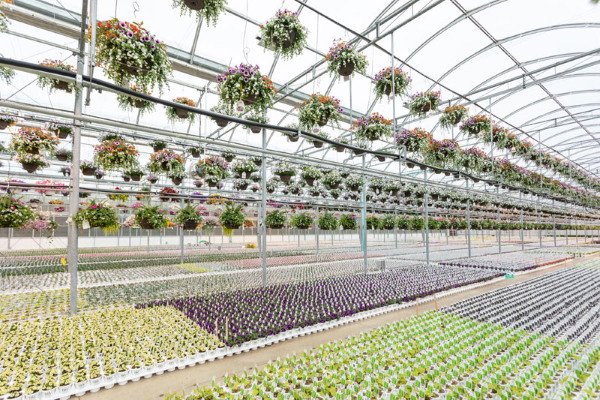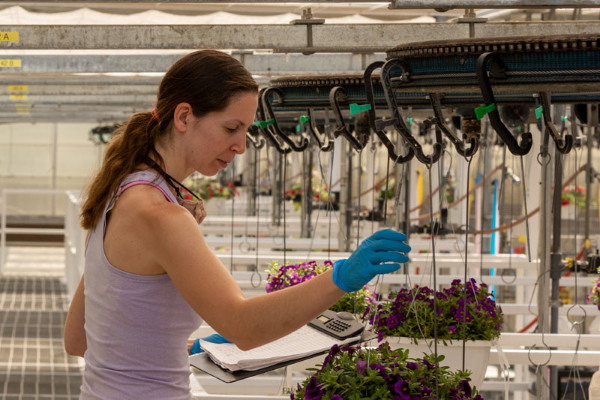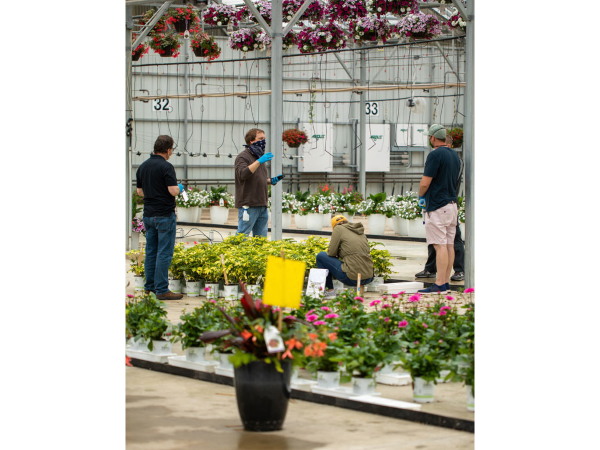Even the best planner could never have predicted how the 2020 growing season was going to develop. Lockdowns in response to the COVID-19 pandemic disrupted the normal growing season, causing many growers to abruptly pull back on planting mid-season. Then, a strong surge in demand took the industry by surprise as millions of stay-at-home families decided to try gardening, some for the first time. This caused many growers and retailers to scramble to find plant material.
These surprising events had many wondering how to best plan for next year. Some in the industry are predicting an extended boom of demand, while others think this year is an outlier. Since planning for any growing season is essentially predicting the future, experienced growers tend to rely on tried-and-true planning basics to develop viable production plans.

Supertunia Royal Velvet Petunia
What’s an ‘average’ year?
“We’re always at the whim of the weather,” says Dennis Crum, Director of Growing Operations at Four Star. “Everyone wants a sunny, warm spring, but we often get a slow start, especially in the north. Someone told me long ago to plan for an ‘average’ growing year. By doing so, you will be correct nine years out of 10.”
As with previous years, Four Star’s plans for 2020 relied on detailed data of what was grown in 2019 and what was sold at retail. “Once COVID-19 hit, we backed off on a lot of our finished products, like uprights, hanging baskets, Grande™ containers, etc.,” he explains. “Most growers were doing something similar, or even eliminating some crops.
“Then things opened up, and there was pent-up demand for plants, like there had been for toilet paper and meat,” he continues. “Sales went crazy and there wasn’t enough material to go around. We did last-minute planting of thousands of Grande trays and hanging baskets. Sales demands were so high we even shipped items we considered to be ‘prefinished’ by our standards, because customers were desperate for product. In many cases, we were shipping material earlier than originally scheduled.”
In the middle of this, Brent Troost started his new position as incoming Director of Growing Operations, working jointly with Crum through transition in 2020. Both are looking now at the data on what Four Star planned for 2020, what was actually planted this year, and what was sold — to determine a plan for 2021. They don’t have a solid plan yet, but do know how some varieties will fit into it.

Brent Troost and Dennis Crum, Directors of Growing Operations
Crum estimates that Four Star ended up planting about 80% of what they originally planned. “Then, as the sales demand rose, we began planting much more to meet the ‘new demand.’ We planted a lot and we could have sold even more. But does that mean we should plan for 20% to 25% more in 2021? That will take a closer look,” he says.
“There are some items we always seemed to be pulling a week or more early because they were so popular. We may plant even more of them next year,” Crum says. “On the other hand, this year you could sell anything — even those less popular varieties. We might plant less of those in 2021.”
High availability for growers
“Our availability is what sets us apart from other growers,” notes Crum. Because Four Star is a spec grower, the variety and numbers of available plants gives growers flexibility throughout the selling season.
“When Michigan finally opened up and garden centers were allowed to open, many growers jumped on board and were able to get material to grow,” he adds.
Troost agrees. “You don’t see spec growing a lot anymore, although it used to be the norm. It allows growers to be flexible and get some plant material they weren’t planning for.”

“Our availability is what sets us apart from other growers,” says Dennis Crum, Director of Growing. This ability to grow on spec gives growers more flexibility as the season evolves.
Four Star’s production system has been developed over the years to provide ongoing availability of plant material throughout the season. “This is a bonus for growers with last-minute needs, as they can always count on us for availability,” Troost adds. In an average year, Four Star often has 3 to 5 million liners available to meet growers’ needs.
Circumstances can change quickly, as they did this year, and growers need to be able to adapt and change production to fit the circumstances. Crum noted that several Four Star programs can help growers quickly add in a turn during the season (Supernova® Liners) or finish faster (Grandes). “We also have a fast, outstanding delivery system to make sure those plants arrive healthy and ready to go,” he explains.
Planning basics
Part of planning for next year’s production is taking a hard look at this year’s production successes and challenges. Crum suggests growers review varieties that were easy or hard to grow, and whether those high-maintenance varieties are worth the time and effort in the future. There may be other easier-to-grow crops worth looking into, he says.

Dennis and Brent recommend growers look closely at what plants sold best when planning for the next season, taking into account new varieties and their own capacity.
He also researches the marketplace each year, trying to determine what garden centers and home gardeners want, what the employees think about them, what products may have potential shipping issues, and what pricing options exist.
Part of this research is looking into new varieties that debut every year, and finding a way to fold those into an efficient production plan. “One thing you need to do is remember to add in new varieties,” Crum explains. “For instance, this year there are some outstanding new options from Proven Winners, like the improved Supertunia Royal Velvet Petunia, Superbells Coral Sun Calibrachoa, and High Noon Euryops, to name just a few. Plants like these can be terrific additions.”

Left to right: Superbells Coral Sun Calibrachoa; Hight Noon Euryops; Machu Morado Ruellia
Study what plants sell best, he stresses. “And look carefully at what’s suitable for your region. A great new plant is Machu Morado Ruellia, which is ideal for growing in the Deep South.” He noted that while Proven Winners plants perform well across all regions, some are outstanding performers in certain regions, and Machu is an example of an outstanding plant that thrives in the south.
Finally, Crum and Troost suggest growers carefully tie their 2021 growing plan to their growing space available. They note it’s much easier to grow plants together with similar growing requirements, and that can save space. If growers try to grow too many plants together, especially with many varieties, Crum warns that can compromise the crop.

Four Star’s growers are finalizing production plans now for the 2021 season, taking into account past sales, production capabilities and new opportunities.
One easy way to simplify production and grow plants together very efficiently is to take advantage of the Benchrun Collections for cool or warm crops. Each collection includes between 25 and 30 top-selling Grande varieties with similar rooting out and growing on temperatures, water requirements and PGR rates. For more information, click here.
Finalizing a plan
While Four Star’s growing team is currently refining a 2021 plan, they continue to discuss options, planned turns, finished materials and more.
“We’re looking very hard at our 2020 plan,” says Crum. “We originally planted about 80% of that but eventually planted nearly up to our original planned amounts. So I guess that overall, we’ll plan on an increase over that amount. But we still have a lot of planning to do before we make a final decision.”
He notes that even though sales ended up being strong, it was a very strange season. “Our owner, Tom Smith, noted that if all growers planted everything they originally planned for 2020, there may have been enough material in the marketplace. But, if all growers plan a 20% to 25% increase for 2021 over 2020’s plan, there could easily be overproduction in 2021.”
Troost points out that 2020’s circumstances encouraged many younger people to try gardening, which should have a positive effect in the industry in coming years. “This is a great opportunity for our industry — we’re finally getting these kids on board,” he says.
Both growers have several years of experience and they continue to rely on solid planning basics as their main guide for each upcoming season. As Crum explains, “I try to be optimistic, and I’m also realistic.”
Learn more at FSU On Demand
Dennis and Brent, along with other Four Star growers, will be offering more in-depth planning ideas and cultivation tips at the upcoming Four Star University On Demand, coming in late September. Contact them for more information at [email protected] or by calling at 734-654-6420.
